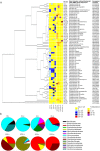Potential for plant growth promotion by a consortium of stress-tolerant 2,4-dinitrotoluene-degrading bacteria: isolation and characterization of a military soil
- PMID: 24467368
- PMCID: PMC4241723
- DOI: 10.1111/1751-7915.12111
Potential for plant growth promotion by a consortium of stress-tolerant 2,4-dinitrotoluene-degrading bacteria: isolation and characterization of a military soil
Abstract
The presence of explosives in soils and the interaction with drought stress and nutrient limitation are among the environmental factors that severely affect plant growth on military soils. In this study, we seek to isolate and identify the cultivable bacteria of a 2,4-dinitrotoluene (DNT) contaminated soil (DS) and an adjacent grassland soil (GS) of a military training area aiming to isolate new plant growth-promoting (PGP) and 2,4-DNT-degrading strains. Metabolic profiling revealed disturbances in Ecocarbon use in the bare DS; isolation of cultivable strains revealed a lower colony-forming-unit count and a less diverse community associated with DS in comparison with GS. New 2,4-DNT-tolerant strains were identified by selective enrichments, which were further characterized by auxanography for 2,4-DNT use, resistance to drought stress, cold, nutrient starvation and PGP features. By selecting multiple beneficial PGP and abiotic stress-resistant strains, efficient 2,4-DNT-degrading consortia were composed. After inoculation, consortium UHasselt Sofie 3 with seven members belonging to Burkholderia, Variovorax, Bacillus, Pseudomonas and Ralstonia species was capable to successfully enhance root length of Arabidopsis under 2,4-DNT stress. After 9 days, doubling of main root length was observed. Our results indicate that beneficial bacteria inhabiting a disturbed environment have the potential to improve plant growth and alleviate 2,4-DNT stress.
© 2014 The Authors. Microbial Biotechnology published by John Wiley & Sons Ltd and Society for Applied Microbiology.
Figures




Similar articles
-
[Biodegradation of 2, 4- and 2, 6-dinitrotoluene in a pilot-scale system for soil contaminated with explosive compounds].Huan Jing Ke Xue. 2007 Mar;28(3):613-6. Huan Jing Ke Xue. 2007. PMID: 17633643 Chinese.
-
Remediation of dinitrotoluene contaminated soils from former ammunition plants: soil washing efficiency and effective process monitoring in bioslurry reactors.J Hazard Mater. 2001 Oct 12;87(1-3):139-54. doi: 10.1016/s0304-3894(01)00240-0. J Hazard Mater. 2001. PMID: 11566406
-
Microbial consortia that degrade 2,4-DNT by interspecies metabolism: isolation and characterisation.Biodegradation. 2003;14(1):19-29. doi: 10.1023/a:1023539104747. Biodegradation. 2003. PMID: 12801097
-
Exopolysaccharides producing rhizobacteria and their role in plant growth and drought tolerance.J Basic Microbiol. 2018 Dec;58(12):1009-1022. doi: 10.1002/jobm.201800309. Epub 2018 Sep 5. J Basic Microbiol. 2018. PMID: 30183106 Review.
-
Phytoremediation: synergistic use of plants and bacteria to clean up the environment.Biotechnol Adv. 2003 Aug;21(5):383-93. doi: 10.1016/s0734-9750(03)00055-7. Biotechnol Adv. 2003. PMID: 14499121 Review.
Cited by
-
A selective genome-guided method for environmental Burkholderia isolation.J Ind Microbiol Biotechnol. 2019 Mar;46(3-4):345-362. doi: 10.1007/s10295-018-02121-x. Epub 2019 Jan 24. J Ind Microbiol Biotechnol. 2019. PMID: 30680473
-
The Response of Red Clover (Trifolium pratense L.) to Separate and Mixed Inoculations with Rhizobium leguminosarum and Azospirillum brasilense in Presence of Polycyclic Aromatic Hydrocarbons.Int J Environ Res Public Health. 2020 Aug 9;17(16):5751. doi: 10.3390/ijerph17165751. Int J Environ Res Public Health. 2020. PMID: 32784849 Free PMC article.
-
Nicotiana tabacum-associated bioengineered Pseudomonas putida can enhance rhizoremediation of soil containing 2,4-dinitrotoluene.3 Biotech. 2020 Sep;10(9):398. doi: 10.1007/s13205-020-02395-y. Epub 2020 Aug 19. 3 Biotech. 2020. PMID: 32864284 Free PMC article.
-
Application of Sodium Silicate Enhances Cucumber Resistance to Fusarium Wilt and Alters Soil Microbial Communities.Front Plant Sci. 2018 May 11;9:624. doi: 10.3389/fpls.2018.00624. eCollection 2018. Front Plant Sci. 2018. PMID: 29868080 Free PMC article.
-
The Interaction between Plants and Bacteria in the Remediation of Petroleum Hydrocarbons: An Environmental Perspective.Front Microbiol. 2016 Nov 21;7:1836. doi: 10.3389/fmicb.2016.01836. eCollection 2016. Front Microbiol. 2016. PMID: 27917161 Free PMC article. Review.
References
-
- Arshad M, Saleem M, Hussain S. Perspectives of bacterial ACC deaminase in phytoremediation. Trends Biotechnol. 2007;25:356–362. - PubMed
-
- Barac T, Taghavi S, Borremans B, Provoost A, Oeyen L, Colpaert JV, et al. Engineered endophytic bacteria improve phytoremediation of water-soluble, volatile, organic pollutants. Nat Biotechnol. 2004;22:583–588. - PubMed
-
- Bloch E, Gondos B, Gatz M, Varma SK, Thysen B. Reproductive toxicity of 2,4-dinitrotoluene in the rat. Toxicol Appl Pharmacol. 1988;94:466–472. - PubMed
-
- Boopathy R. Bioremediation of explosives contaminated soil. Int Biodeterior Biodegradation. 2000;46:29–36.
-
- Brannon JM, Pennington JC. Environmental Fate And Transport Process Descriptors for Explosives. US Army Corps of Engineers: Engineer Research and Development Center; 2002. Environmental Laboratory, Vicksburg, Mississippi, Technical Report ERDC/EL TR-02-10.
Publication types
MeSH terms
Substances
LinkOut - more resources
Full Text Sources
Other Literature Sources
Molecular Biology Databases
Miscellaneous

